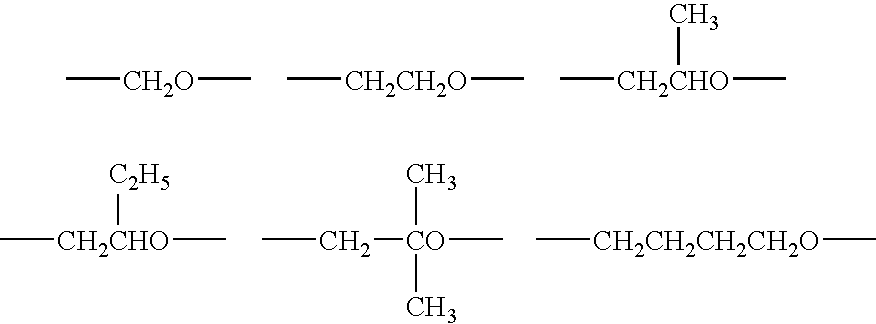Curable composition and methods for improving recovery properties and creep properties
a composition and composition technology, applied in the field of cureable composition and methods for improving recovery properties and creep properties, can solve the problems of distorted adhesion layers with time, and achieve the effects of excellent recovery properties, durability and creep resistan
- Summary
- Abstract
- Description
- Claims
- Application Information
AI Technical Summary
Benefits of technology
Problems solved by technology
Method used
Image
Examples
synthesis example 1
[0339]Using polyoxypropylenetriol having a molecular weight of about 3,000 as an initiator, propyleneoxide was polymerized in the presence of a zinc hexacyanocobaltate glyme complex catalyst to obtain polypropylene oxide having a number average molecular weight of about 26,000 (molecular weight relative to polystyrene standards as measured by using a HLC-8120GPC manufactured by Tosoh Corporation as the liquid delivery system, using a TSK-GEL H-type column manufactured by Tosoh Corporation as the column, and using THF as the solvent). Subsequently, a methanol solution of NaOMe was added in the amount of 1.2 equivalent mol per equivalent mol of the hydroxyl group of the hydroxyl-terminated polypropyl eneoxide. The methanol was distilled off and allyl chloride was further added to convert the terminal hydroxyl group into an allyl group. Unreacted allyl chloride was removed by reduced-pressure evaporation. In relation to 100 parts by weight of the obtained crude allyl-terminated polypro...
synthesis example 2
[0347]Using polyoxypropylene glycol having a molecular weight of about 2,000 as an initiator, propylene oxide was polymerized in the presence of a zinc hexacyanocobaltate glyme complex catalyst to obtain a hydroxyl-terminated polypropylene oxide having a number average molecular weight of about 14,500. This hydroxyl-terminated polypropylene oxide was employed to obtain an allyl-terminated polypropylene oxide using the same steps as those used in Synthesis Example 1. This allyl-terminated polypropylene oxide was, in the same manner as in Synthesis Example 1, reacted with trimethoxysilane to obtain a polyoxypropylene polymer (A-2) having on its terminals an average of 1.5 trimethoxysilyl.
synthesis example 3
[0348]Using the same steps as those in Synthesis Example 1, the allyl-terminated polypropylene oxide obtained in Synthesis Example 2 was reacted with triethoxysilane to obtain a polyoxypropylene polymer (A-3) having on its terminals an average of 1.5 triethoxysilyl groups.
PUM
| Property | Measurement | Unit |
|---|---|---|
| temperatures | aaaaa | aaaaa |
| molecular weight distribution | aaaaa | aaaaa |
| molecular weight distribution | aaaaa | aaaaa |
Abstract
Description
Claims
Application Information
 Login to View More
Login to View More - R&D
- Intellectual Property
- Life Sciences
- Materials
- Tech Scout
- Unparalleled Data Quality
- Higher Quality Content
- 60% Fewer Hallucinations
Browse by: Latest US Patents, China's latest patents, Technical Efficacy Thesaurus, Application Domain, Technology Topic, Popular Technical Reports.
© 2025 PatSnap. All rights reserved.Legal|Privacy policy|Modern Slavery Act Transparency Statement|Sitemap|About US| Contact US: help@patsnap.com



